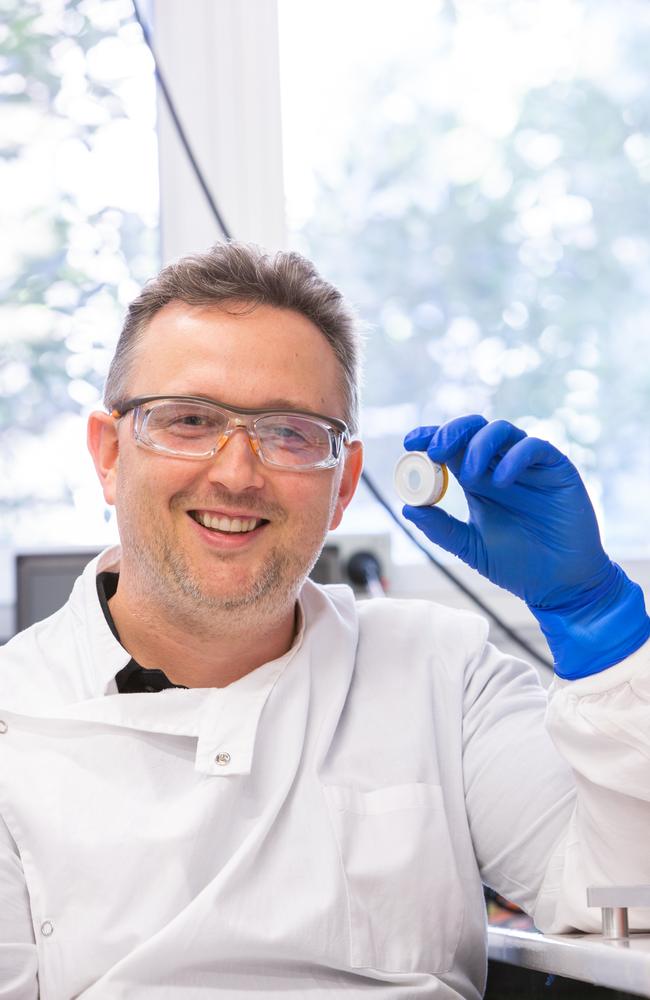‘Cutting-edge’: The Qld scientist hoping to replace jabs with patches
It is hoped a Queensland-made patch will soon replace needle vaccinations. This is how the scientist behind it says it works.
As his colleagues in the molecular clamp lab were dusting themselves off and preparing to work on Clamp 2.0, Dr David Muller was experiencing one of the most exciting times of his career.
For almost a decade, the University of Queensland virologist had been beavering away in the lab, working with vaccines for viruses such as polio and dengue fever and how they could be applied to a small, needle-free patch.
The nanopatch’s time has arrived with the advent of SARS-CoV-2.
It was developed at UQ’s Australian Institute for Bioengineering and Nanotechnology by Professor Mark Kendall who, through the university’s commercialisation arm UniQuest, created the company Vaxxas in 2011 to get the technology to market. Muller had worked in Kendall’s lab as a post-doc and continues to work with Vaxxas.

Muller reaches into his pocket and produces the patch, officially the high-density microarray patch, or HD-MAP. It’s enclosed in an applicator about the size of a 50 cent piece and about three centimetres high. The patch itself is small. Smaller still are the 5000 micro-projections embedded into it.
“Those micro-projections are about 250 micrometres in length,” Muller says. “That’s what we coat the vaccine directly on to. We dry it on to those projections and when we apply it to the skin, they deposit the vaccine into the top layers.
“Those layers of skin are rich in immune cells so you get better uptake of the vaccine.”
In fact, trials on mice have shown that a single application produces better and faster immune responses than a needle.
“This type of vaccine delivery system hasn’t been used like this,” Muller says. “This is cutting edge. This is on the forefront of science.”
He’s shy to admit it, given the turmoil and heartache the pandemic has brought, but scientific exploration has benefited from Covid-19. “I feel bad saying it but it’s been good for science,” Muller says. Last year, he was awarded a $300,000 Advance Queensland Industry Fellowship to explore the use of the nanopatch for vaccine delivery. “We’ve gone from basically being nowhere … to adapt this vaccine to the patch and demonstrate that it works in animals and is able to neutralise a variety of different SARS-CoV-2 variants.”
Muller is a former student of Professor Paul Young’s and says he was “a massive inspiration” for his career. As a second-year undergraduate, Muller was considering abandoning science until attending a lecture by Young on viruses and “a lightbulb went on”. While the potential exists to use the UQ Clamp 2.0 vaccine for the patch, Muller and Vaxxas are collaborating with the University of Texas’s Hexapro vaccine candidate. It’s also a protein vaccine.
Hexapro is a highly stable vaccine which does not need to be kept refrigerated. Tests have shown that when applied to the patch, it maintained its stability after 30 days at 25 degrees, making it especially attractive for remote regions or developing countries.

“It’s very easy to use, there’s no need for trained medical staff to apply it,” Muller says. Just press it on to your skin, hold it for 10 seconds, and you’re vaccinated.
Even more exciting than the idea of no needles is the adaptability of the patch as new variants are discovered and vaccines are altered.
“We could have a section which is for the Alpha variant and a section for the Delta variant and so on. So, we could update this as required.”
The plan is to launch Phase 1 clinical trials by the second quarter of next year. The Queensland Government and Vaxxas have signed an agreement for the construction of a medical plant in Brisbane’s Hamilton, with the aim of producing 300 million doses of the patch delivery system next year.
“We’re positioning ourselves in the booster market,” Muller says. “As these variants come forward, you could have a vaccine patch booster.”



